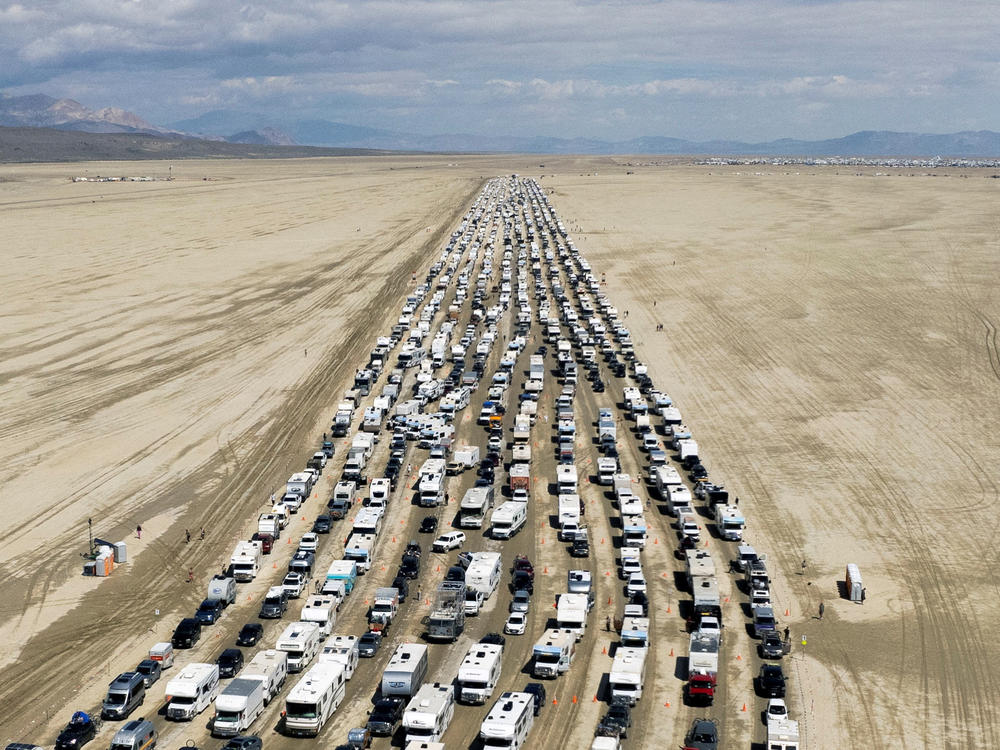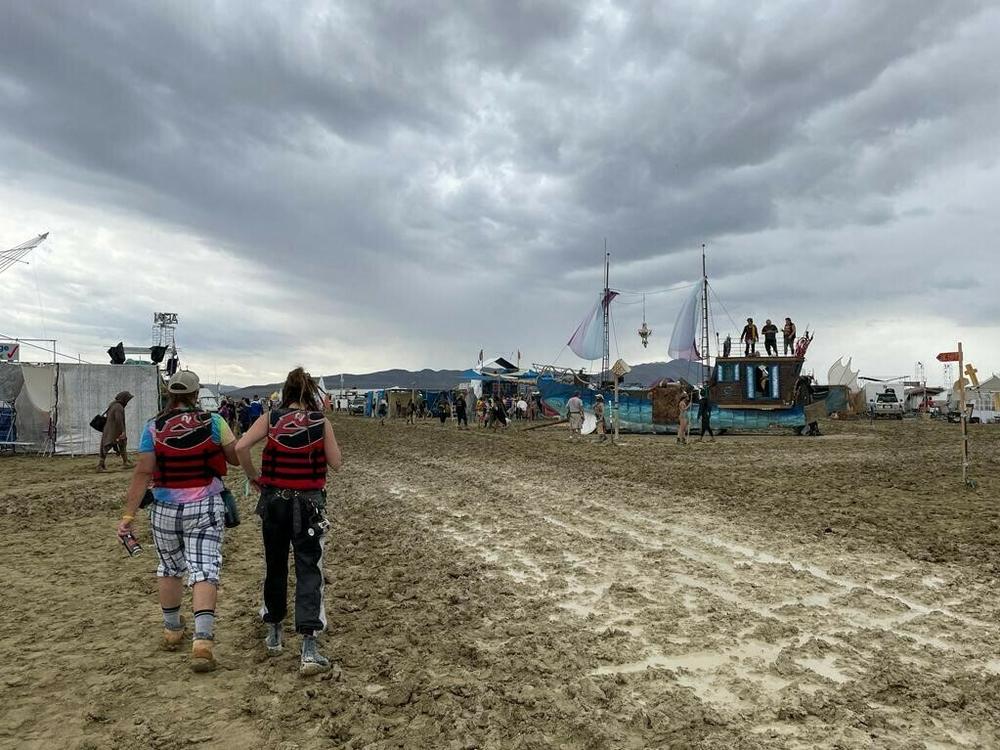Section Branding
Header Content
Burning Man attendees say learning to live with the unexpected is part of the program
Primary Content
Updated September 5, 2023 at 7:52 PM ET
Heavy rains and thick mud stranded thousands at this year's Burning Man music and arts festival in Nevada's Black Rock Desert. But some who were caught in the mix said learning to roll with the mayhem is part of the experience.
Festival organizers lifted a driving ban on Monday afternoon as muddy roads that had stranded thousands of attendees in the Nevada desert had dried up enough to allow people to begin leaving.
"Exodus operations have officially begun in Black Rock City," organizers posted Monday at 2 p.m. local time, about seven hours before the festival's fiery conclusion. The torching of a giant, faceless, man-shaped effigy was carried out Monday evening, after having been postponed twice due to the weather.
But as of Tuesday morning, the festival was asking participants to consider staying a little longer if they could.
Traffic was so congested that at one point, it was taking drivers roughly seven hours to traverse a 5-mile route, pocked with puddles, to the nearest paved road. By midmorning, that time had dropped to 2-3 hours, the organizers said on social media.
And that was just the beginning of the journey home for the roughly 72,000 attendees who traveled to the festival's remote site in northern Nevada, about 120 miles north of the nearest airport in Reno. The airport warned on social media that it did not have the facilities to house travelers for long periods of time while they sorted out plans.
"It is business as usual here, as we planned for a busy holiday/Burning Man weekend," a spokesperson for the airport, Stacey Sunday, told NPR over email. "We are providing booties and a wash station for Burning Man attendees."
Even during normal years, exodus traffic jams can last for six to nine hours, according to the organizers. Cars, trucks and RVs stuffed with sleeping bags, stoves and tents all cram onto a single two-lane road leading to the nearest major highway.
But this year's participants had been stranded since Sunday, after storms turned the desert playa into a mud bath. Close to an inch of precipitation flooded the area starting on Friday, prompting event organizers to close access to the festival until vehicles could safely pass and to warn campers to conserve food and water.
Wet weather didn't dampen the Burning Man spirit
Despite reports of stuck vehicles, overflowing port-a-potties, postponed bus pickups and spotty Wi-Fi service, several attendees who spoke to NPR say the wet weather hadn't dampened moods.
"We're pooling all our food as far as resources. And I would say honestly, walking around the city, spirits are pretty high," attendee Anya Kamenetz said on Sunday.
The challenging conditions are testing a community of so-called burners, which touts self-reliance and communal effort among its core principles.
Event volunteer Josh Lease said that in true Burning Man spirit, people were sharing warm clothes and phone chargers where they could — and they kept the music blaring.
"It's like any other Burning Man, just muddy," he told NPR on Saturday evening.
"The warnings do sound very dire, and of course, the organization has to tell people to take care," said Claudia Peschiutta, an editor with NPR's Morning Edition who attended the event, but "I haven't seen one person who seems worried about it at all."
This was the third burn for 29-year-old Maggie Liu, who said she and her two friends were fortunate to be in an RV when the weather rolled in. Liu had brought plenty of supplies in an effort to be prepared for anything, but this year's festival highlighted what was missing from her kit.
"One of our friends brought a pair of galoshes, and he was totally fine," Liu said. "Whereas I didn't prepare as well, and I only brought like the platform, burner boots that absolutely got wrecked in the mud and everything fell apart."
But for her, part of the Burning Man experience is to live in the moment, whether that be good or bad, rain or shine.
"There is that go with the flow aspect where you try and make things work," she explained, "but really, if things don't go as expected, that's, well, pretty much expected that things don't go as expected."
Some frustration, however, started to seep in for some attendees by Sunday.
In rainy Burning Mans past, longtime burner Joe Bamberg said he's seen couches, carpets and clothes eventually dry out. But this time, he said, "all is damp and will be ruined by mold," he said.
"I am not thrilled," said Bamberg, who added: "People make do, it is part of the adventure."
Meanwhile, authorities in Nevada were investigating a death at the site. The Pershing County sheriff said on Saturday that a person was found dead on the playa but declined to offer any further details in an interview with CNN on Monday.
Some burners made the trek out on foot
The Burning Man Organization had begun telling attendees to shelter in place on Saturday, when it announced that access into and out of the site was closed for the remainder of the event, which runs from Aug. 27 through Sep. 4. Only emergency vehicles were allowed to pass, the organization said in a statement.
"Conserve food, water, and fuel, and shelter in a warm, safe space," the statement urged those stuck in the desert.
Alison Burger, a wellness entrepreneur who had been attending her eighth Burning Man, and two of her friends hoofed it out of the festival Saturday after the first storm had struck.
Burger said she and her friends decided to leave Saturday around 5 p.m. after her camp's leadership advised those capable of doing so to leave on foot ahead of incoming storms.
"Five miles didn't seem like that long, but when the ground below you is like wet cement quicksand, it's very difficult to trudge through," Burger said. "Because you know, it sticks to your feet and builds up layer after layer."
One of their party stayed behind with their vehicle to eventually drive it out, but Burger said their supplies were made available to those in need.
Although they urged attendees against driving on Sunday, event officials said that some vehicles designed for off-road terrain had been able to navigate the mud and successfully leave the event.
Other attendees chose to walk several miles across the muck to exit the grounds.
Music producer Diplo said he and comedian Chris Rock escaped the event on Saturday after walking 6 miles before hitching a ride from a fan in a pickup truck.
"I legit walked the side of the road for hours with my thumb out cuz I have a show in dc tonight and didnt want to let yall down," he wrote in an Instagram post.
Neal Katyal, former acting Obama-era solicitor general, also made the trek out. He said he was safe after his first trip to the festival ended with "an incredibly harrowing 6-mile hike at midnight through heavy and slippery mud."
President Biden had been briefed on the situation, according to a White House official. Event attendees were told over the weekend to listen to state and local officials, and event organizers, the administration official said.
"We have come here knowing this is a place where we bring everything we need to survive," the organization said in a statement Saturday night. "It is because of this that we are all well-prepared for a weather event like this."
"We have done table-top drills for events like this. We are engaged full-time on all aspects of safety and looking ahead to our Exodus as our next priority."
More than 70,000 people visit the makeshift town of Black Rock City every year to dance, make art and join a self-sufficient, counter-cultural community.
The weeklong festival began in 1986 as a small gathering in San Francisco. Today, celebrities, tech moguls and social media influencers are common attendees. This year's ticket prices started at $575.
The weekend's events weren't the first time the entrance had been blocked at this year's festival. A group of climate protesters caused miles of gridlock at the start of the event by parking a 28-foot trailer in the way.
Copyright 2023 NPR. To see more, visit https://www.npr.org.


